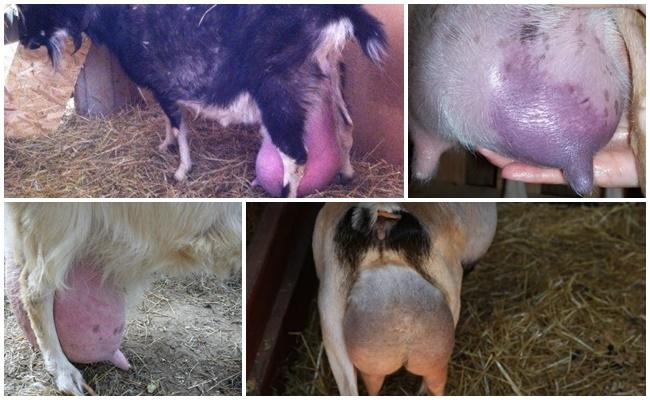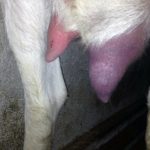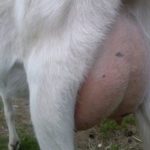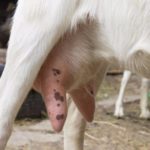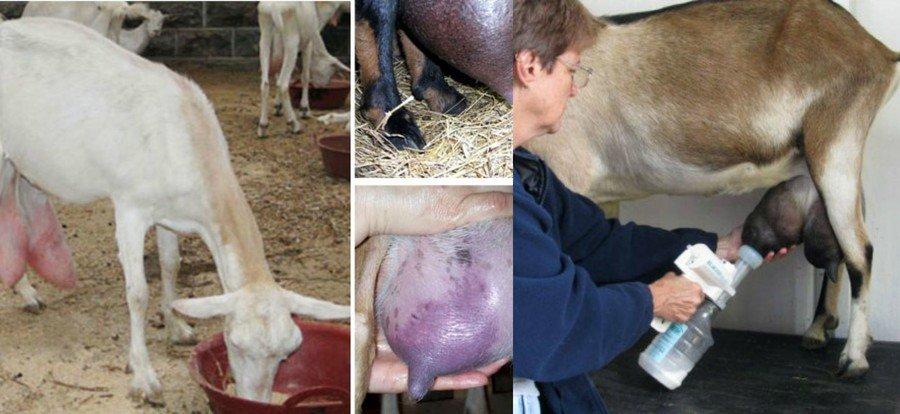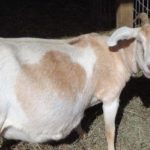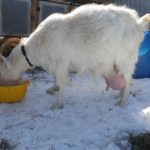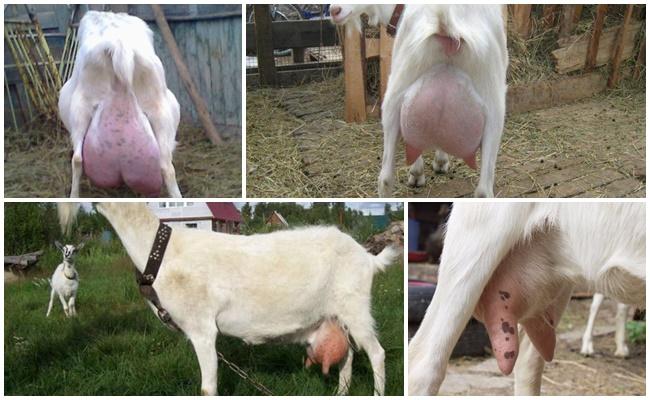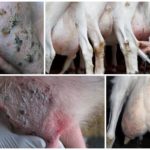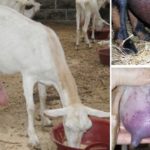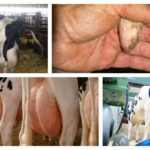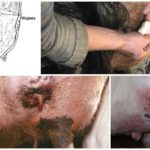Lambing represents a significant burden on the animal's body. During the first pregnancy, it is imperative to keep the female’s condition under control. Sometimes after giving birth, swelling of the goat's udder appears; what to do in such a situation? This question interests many farmers. Medicines and special massage will help to cope with the problem. If you do not help the female in time, there is a risk of problems.
Causes of postpartum udder swelling
Udder edema refers to swelling of the milk ducts.This problem often occurs after lambing and is due to the hormonal changes that the female experiences during pregnancy. It is possible to see the appearance of problems even with a superficial inspection. At the same time, the udder looks larger, acquires a dense structure and changes color, becoming burgundy-red or bluish. From the outside it seems that the organ has become swollen and heavy. This condition is not accompanied by pain, but causes anxiety in the goat. She moves her legs with difficulty and tries not to disturb her mammary glands.
The most common cause of problems is lack of physical activity during pregnancy. An excess of succulent food can also be a provoking factor. In addition, the following factors lead to the causes of problems:
- stagnation of milk in the ducts;
- excess water;
- low room temperatures;
- infection of the female;
- exacerbation of diseases of internal organs - kidneys, heart, liver;
- delayed toxicosis.
How to distinguish from other pathologies
The main sign of problems is considered to be an abnormal increase in size of the udder. It can become 3-4 times larger. In this case, swelling is observed in one lobe or in two at once. The anomaly can also affect the abdomen and chest.
The disease is often accompanied by other symptoms. To identify the problem, you should pay attention to the following features:
- Appearance of the organ. It becomes saggy and swollen. The goat has a hard udder to the touch. It is often possible to palpate enlarged lymph nodes above it. The udder may be as hard as a rock. Moreover, it is not hot, but cool.
- Milking quality. With swelling, there is often little milk. Sometimes the discharge does not have a liquid, but a cheesy structure.
- General state. The female may experience an increase in body temperature.The animal may refuse to eat, feel increased drowsiness and weakness.
- Additional signs. Sometimes the udder becomes covered in rashes. In this case, the eyes and eyelids may acquire a reddish tint. Mucus discharge is observed from the nose.
Diagnostics
A visual examination allows you to identify the development of pathology. When swelling occurs, the udder increases significantly in size and changes color. In this case, the organ becomes swollen and saggy. If such symptoms appear, it is recommended to observe the goat’s behavior for several days. This will help determine the severity of discomfort. You should also gently knead the udder with your hands. The organ may be firm to the touch. In some cases, lumps or nodes are present under the skin.
When pressure is applied to the udder, it slowly regains its shape. There have been indentations from the fingers on the surface for a long time. The skin is cool to the touch. The milk is practically not squeezed out and has a watery consistency.
How to properly treat edema in goats
Typically, swelling after lambing goes away on its own within 1 week. In this case, there is no need for medications. If after 7 days the udder remains firm and the goat is restless and produces little milk, action needs to be taken. First of all, it is recommended to reduce the volume of fluid in the pet’s body. To do this you should do the following:
- reduce the amount of silage and succulent feed in the diet;
- increase physical activity - the goat should be driven around the paddock twice a day;
- limit the amount of water;
- milk the animal more often – 3-5 times a day;
- Isolating the goat from other animals will help prevent traumatic injuries;
- Massage the udder daily - it is recommended to do this before and after milking.
The massage should be done with warm hands, moving from the nipples to the base of the udder. The use of creams or solutions with irritating effects is prohibited. Sometimes farmers use Vaseline. It is also permissible to use baby cream.
Drug therapy after lambing is carried out using special agents that promote vascular restoration. To do this you should use the following:
- calcium gluconate – 100 milliliters of the substance should be administered once a day;
- calcium chloride solution – 150 milliliters is recommended to be administered intravenously 2 times a day;
- caffeine benzoate sodium - 20 milliliters of the drug is administered once a day to normalize heart function.
To reduce swelling, you should use poultices made from herbal dust. It is also recommended to use warm wraps. If the udder sag under the influence of gravity, it should be tied up. If it comes into contact with the ground, there is a risk of serious injury. Sometimes veterinarians prescribe ointments with anti-inflammatory properties.
To prepare such infusions you should use the following:
- juniper berries - take 100 grams of raw material per 1 liter of water and give the goat 100 milliliters per day;
- birch buds - take 50 grams of raw material per 1 liter of water and give the female 1 small spoon per day;
- horsetail - take 50 grams of herb per 1 liter of water and give the goat 1 teaspoon per day.
Correctly selected treatment will help cope with swelling in 1-2 weeks.If excess fluid continues to accumulate in the tissues, you should consult a veterinarian.
What could be the consequences?
A slight swelling is not dangerous for the animal. If the goat does not feel pain, there is no need to worry. However, it is still necessary to treat the female, since the cubs may experience a lack of milk.
If swelling persists for a long time, there is a risk of developing dangerous pathologies. These include the following:
- mastitis;
- infections;
- sepsis;
- gangrene;
- tissue necrosis.
In this case, the animal completely stops producing milk, and in the most difficult situations, it dies.
Prevention measures
To avoid problems, it is necessary to feed the goat properly during pregnancy. It is important to reduce the amount of succulent and sour food. The basis of nutrition should be high-quality hay. If the goat is very thirsty, the amount of water should be limited. This is especially important during the last two weeks of pregnancy.
Also, to prevent problems, you should adhere to the following rules:
- keep the goat in a warm room without dampness and drafts;
- systematically carry out cleaning - remove manure, change litter;
- start the goat 1.5 months before lambing;
- Let the animal go for a walk every day - it should last at least 1-2 hours.
The appearance of edema after lambing is observed very often. In most cases, this condition is not dangerous. But sometimes it causes mastitis and other negative consequences. That’s why it’s so important to start treatment in a timely manner.

